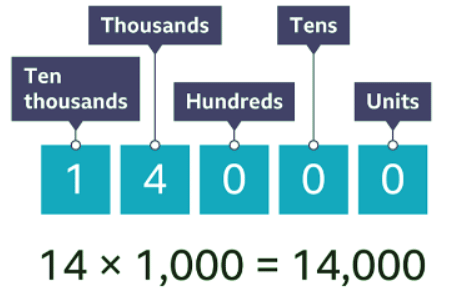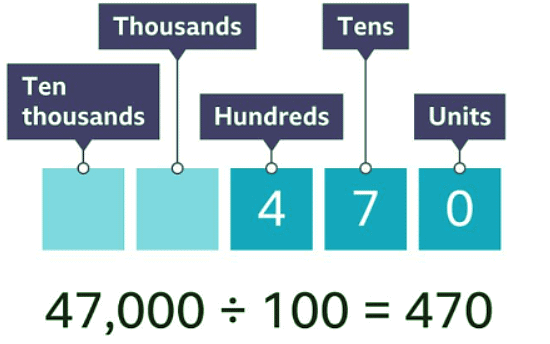How to Multiply or Divide by 10, 100, or 1000 Using Place Value - Year 7 PDF Download
| Table of contents |

|
| Introduction |

|
| Multiplying by 10, 100 and 1,000 |

|
| Dividing by 10, 100 and 1,000 |

|
| Real-world maths |

|
Introduction
- Understanding Place Value: Place value refers to the value of a digit based on its position in a number. For example, in the number 1482, the digits represent 1 thousand, 4 hundreds, 8 tens, and 2 units. This concept is essential as it helps us multiply or divide whole numbers by 10, 100, or 1,000.
- Multiplication using Place Value: When multiplying whole numbers by 10, 100, or 1,000, each digit shifts to the left. This means that the digit's value increases by a factor of 10, 100, or 1,000 depending on its position.
- Division using Place Value: Conversely, when dividing whole numbers by 10, 100, or 1,000, each digit moves to the right. This results in a decrease in the digit's value as it is divided by 10, 100, or 1,000 based on its position.
Multiplying by 10, 100 and 1,000
Place Value: The value of a digit that depends on its position within a number. For instance, in 1482, the digits represent 1 thousand, 4 hundreds, 8 tens, and 2 units. Understanding place value is crucial when multiplying by 10, 100, and 1,000.
Multiplying by 10
- Multiplication by 10 involves shifting each digit one place to the left, changing units to tens.
Multiplying by 100
- When we multiply by 100, every digit shifts two places to the left, transforming units into hundreds.
Multiplying by 1,000
- Similarly, multiplying by 1,000 entails shifting each digit three places to the left, converting units to thousands.
Note: In some cases, units are also referred to as ones. For instance, in the number 34, there are 3 tens and 4 units or ones.
Example
Example: What is 14 x 1,000?
Sol: When multiplying by 1,000, each digit moves three places to the left. Insert a 0 as a placeholder in the hundreds, tens, and units place.
14 x 1,000 = 14,000
Dividing by 10, 100 and 1,000
Understanding place value is crucial when dividing by 10, 100, and 1,000. When dividing by powers of 10 (such as 10, 100, 1,000), the result may contain trailing zeros after the decimal point that are not necessary to include.
Dividing by 10
- When dividing by 10, each digit shifts one place to the right. For instance, thousands transform into hundreds, hundreds into tens, and tens into units.
Dividing by 100
- Dividing by 100 involves shifting each digit two places to the right. Thousands become tens, hundreds become units, and tens and units turn into fractions of a unit.
Dividing by 1,000
- When dividing by 1,000, every digit moves three places to the right. Thousands become units, while hundreds, tens, and units transform into fractions of a unit.
Example
Example: What is 47,000 ÷ 100?
Sol: When dividing by 100, each of the digits moves two places to the right.
470.00 is the same as 470, so remove the zeros after the decimal point.
47,000 ÷ 100 = 470
Real-world maths
- People may use multiplying or dividing by 10, 100 or 1,000 to work out the cost of different items.
- Expensive items are not always paid for in full. Sometimes they are paid for in a number of instalments. For example, a games console costs £450.
- A person may want to split their payment over 10 months to make it more affordable. They would need to be able to divide £450 by 10 to calculate the monthly payments.
- A shop owner may use this method to calculate profits. For example, they know that they make £2 profit for each box of chocolates they sell. If they sell 100 boxes in a month, they need to multiply by 100. 100 x £2 = £200 profit.

FAQs on How to Multiply or Divide by 10, 100, or 1000 Using Place Value - Year 7
| 1. How do you multiply by 10 using place value? |  |
| 2. How do you divide by 100 using place value? |  |
| 3. Can you explain how to multiply by 1,000 using place value? |  |
| 4. What is the significance of place value when multiplying or dividing by 10, 100, or 1,000? |  |
| 5. How can understanding place value help in real-world math situations involving multiplication or division by 10, 100, or 1,000? |  |


















